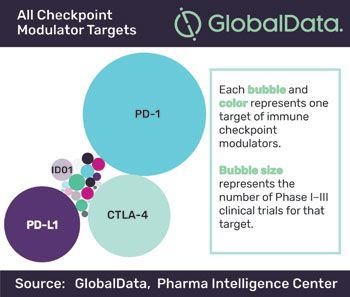Immuno-oncology "Set to Become the Fifth Pillar of Cancer Treatment"
Immuno-oncology (IO) looks set to become the fifth pillar of cancer treatment alongside surgery, radiotherapy, chemotherapy, and other targeted treatments according to a report from GlobalData. â¨â¨The company’s health team analyzed over 4,000 clinical trials and more than 800 IO products in Phase I–III clinical trials to generate a number of unique actionable insights in their report, Pharma Focus Visual Analysis of Immuno-Oncology Development and Opportunities. The report predominantly focuses on developments in active immunotherapy products based on their molecular targets and molecule types. The team also assessed immune checkpoint modulators (based on 21 individual targets) together with a total of 18 solid tumor types and eight blood cancers.

A large selection of treatments within immune-oncology focus on utilizing the immune system to induce an anti-tumor response, leading to tumor stabilization and potential remission from the disease. These treatments achieve their effects through the inhibition, or blockade, of immune checkpoint proteins (ICPs) such as CTLA-4 and PD-1. PD-(L)1 inhibitors are rapidly adopted in indications receiving approval due to significant survival benefit and relatively good safety profiles in comparison with other Standard Of Care (SOC) treatments. The number of regulatory designations generally correlates with the number of first-to-market indications.â¨â¨ Maxime Bourgognon, Senior Healthcare Analyst at GlobalData, commented: ‘‘The future of IO looks brighter than ever, and IO drugs are now in a position to compete as monotherapies against traditional SOC chemotherapy regimens in the first line of the metastatic setting. In addition, these treatments have shown efficacy in a wide variety of indications offering a less toxic treatment alternative.’’
Addressing Disparities in Psoriasis Trials: Takeda's Strategies for Inclusivity in Clinical Research
April 14th 2025LaShell Robinson, Head of Global Feasibility and Trial Equity at Takeda, speaks about the company's strategies to engage patients in underrepresented populations in its phase III psoriasis trials.
Key Findings of the NIAGARA and HIMALAYA Trials
November 8th 2024In this episode of the Pharmaceutical Executive podcast, Shubh Goel, head of immuno-oncology, gastrointestinal tumors, US oncology business unit, AstraZeneca, discusses the findings of the NIAGARA trial in bladder cancer and the significance of the five-year overall survival data from the HIMALAYA trial, particularly the long-term efficacy of the STRIDE regimen for unresectable liver cancer.
Expanding Immune Response Testing to Support Vaccine Development
April 22nd 2025Nigel McCracken, chief operating officer, Virax Biolabs, discusses the expansion of its ViraxImmune platform into areas such as transplant monitoring, vaccine efficacy, latent virus reactivation, and CAR T cell therapy.